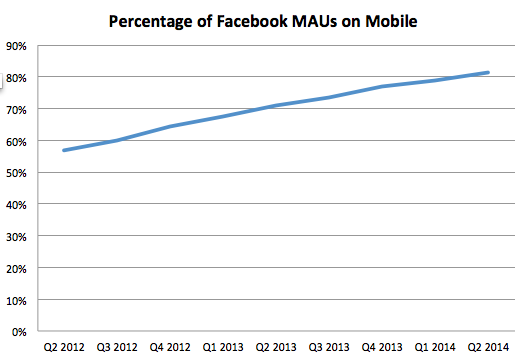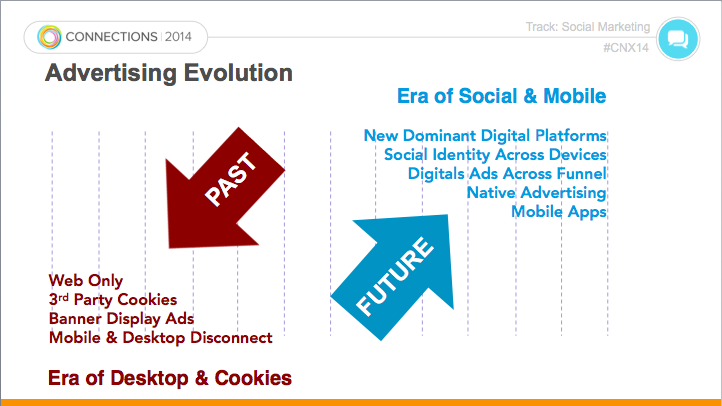
Get your FREE 30-day trial.
Please complete all fields.
And the future is now. Mobile adoption has exploded and shows no signs of slowing down. It's amazing how quickly people are switching from desktops and laptops to mobile for both their personal lives. And as Salesforce CEO Marc Benioff showed during the Connections opening keynote, they are switching to mobile devices to run their professional lives as well.
During today's breakout sessions, the Director of Client Strategy and Development for Resolution Media, George Manas, and Facebook's manager of strategic partnerships, Ravi Adusumilli, both shared extensive data about how quickly mobile adoption broadly, and Facebook adoption specifically, have grown.
Of the 1.3 billion Facebook users, 1.1 billion of them are on mobile today. That's 81% of all Facebook users, up from 60% in Q2 2013. Not only that, but 399 million Facebook users are mobile only today, up from 219 million one year ago. As George said, Facebook had exactly zero dollars of mobile ads revenue when it IPO'd. By Q2 2014, 62% of Facebook's revenue is from mobile ads!
What does all of those users mean for the broader mobile ecosystem? One in every four minutes of global smartphone users' time is spent on Facebook. In fact, people spend more time with Facebook on mobile than the ten next biggest mobile properties, combined! These users are heavily invested in the Facebook app on both iOS and Android (including the new iPhone 6!) and their time in-app far outstrips other app usage. Today, 86% of time on mobile is spent on apps, as Ravi presented. He also described how more than half of all travel bookings are made via mobile apps.
This is a signal of a major change in how advertisers buy and target their ads. Until recently, digital advertising meant web-only ads. As an advertiser, you could rely on third party cookies to target your ads, and search and banner ads to reach your audience.
Mobile users break this model. Advertisers can't do user-based third-party cookies on mobile, and neither classic banner nor search ads work in a mobile app-first environment. In fact, according to Facebook internal data Ravi presented, 67% of mobile users start shopping on one device and finish on another. Instead, dominant digital platforms including Facebook, Twitter, and LinkedIn maintain users' social identities across devices and enable native advertising that's highly targeted and personalized on a one to one basis. 
George Manas of Resolution Media showed the power of targeting customers on mobile devices for a campaign that drove downloads of a global media brand's new video. With narrow targeting and custom audiences, Resolution Media showed ads only to interested buyers on iPhones and iPads, with a click-to-download button right in the ads. These ads leads to a 28% increase in advertising efficiency, a 30% lift in engagement, and a 15% gain in purchase intent.
In his breakout session, Ravi Adusumilli walked through how powerful mobile ads can be not just for app installs and downloads, but also for downstream conversions. Today's mobile story is much broader than just immediate installs, because Facebook's data clearly shows that even if a customer later makes a purchase on a desktop computer, they are often first influenced to make the purchase by an ad on mobile.
As a social advertiser, you should engage with your audiences where they spend their time today, which means reaching them on their mobile devices as well as in other channels and locations.